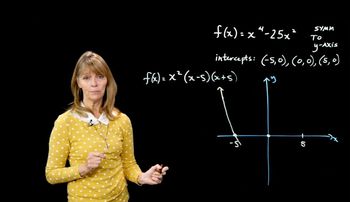Table of contents
- 0. Review of Algebra4h 16m
- 1. Equations & Inequalities3h 18m
- 2. Graphs of Equations43m
- 3. Functions2h 17m
- 4. Polynomial Functions1h 44m
- 5. Rational Functions1h 23m
- 6. Exponential & Logarithmic Functions2h 28m
- 7. Systems of Equations & Matrices4h 6m
- 8. Conic Sections2h 23m
- 9. Sequences, Series, & Induction1h 19m
- 10. Combinatorics & Probability1h 45m
4. Polynomial Functions
Dividing Polynomials
Problem 41
Textbook Question
Use synthetic division to divide f(x)=x^3−4x^2+x+6 by x+1. Use the result to find all zeros of f.
 Verified step by step guidance
Verified step by step guidance1
Step 1: Set up the synthetic division. Write the coefficients of the polynomial f(x) in descending order of their degree. For f(x) = x^3 - 4x^2 + x + 6, the coefficients are 1, -4, 1, and 6. Write these in a row. To the left of this row, write the value that makes the divisor equal to zero. For x + 1, this value is -1.
Step 2: Carry the first coefficient (1) straight down. Then multiply this by the value you wrote to the left (-1) and write the result under the second coefficient (-4). Add these two numbers together and write the result under the line.
Step 3: Repeat the process from step 2 for the remaining coefficients. Multiply the result you just wrote by the value to the left (-1), write the result under the next coefficient (1), and add these two numbers together. Repeat this one more time for the last coefficient (6).
Step 4: The numbers you have written under the line represent the coefficients of the quotient polynomial. The degree of this polynomial is one less than the degree of the original polynomial. So, if the original polynomial was of degree 3, the quotient polynomial is of degree 2. The last number you wrote is the remainder.
Step 5: To find the zeros of f, set the quotient polynomial and the divisor equal to zero and solve for x. Don't forget that the value you wrote to the left in step 1 is also a zero of f.
Recommended similar problem, with video answer:
 Verified Solution
Verified SolutionThis video solution was recommended by our tutors as helpful for the problem above
Video duration:
4mPlay a video:
Was this helpful?
Key Concepts
Here are the essential concepts you must grasp in order to answer the question correctly.
Synthetic Division
Synthetic division is a simplified method for dividing a polynomial by a linear binomial of the form x - c. It involves using the coefficients of the polynomial and performing a series of multiplications and additions to find the quotient and remainder. This technique is particularly useful for quickly dividing polynomials and is less cumbersome than traditional long division.
Recommended video:

Higher Powers of i
Polynomial Zeros
The zeros of a polynomial are the values of x for which the polynomial evaluates to zero. Finding these zeros is essential for understanding the behavior of the polynomial function, as they represent the x-intercepts on a graph. The Fundamental Theorem of Algebra states that a polynomial of degree n has exactly n roots, counting multiplicities, which can be real or complex.
Recommended video:

Finding Zeros & Their Multiplicity
Remainder Theorem
The Remainder Theorem states that when a polynomial f(x) is divided by a linear divisor of the form x - c, the remainder of this division is equal to f(c). This theorem is useful for quickly evaluating polynomials at specific points and can help identify potential zeros of the polynomial, as a zero will yield a remainder of zero when evaluated.
Recommended video:

Higher Powers of i
Related Videos
Related Practice

